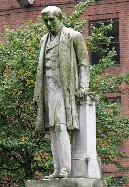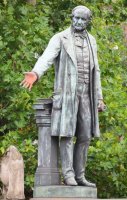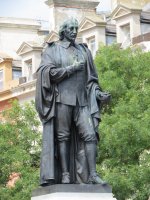Albert Bruce-Joy (1842-1924)
Statue of Oliver Heywood, by Bruce-Joy.
The portrait sculptor Albert Bruce-Joy (name sometimes unhyphenated) was born in Dublin, and educated first on the Continent, and then at the South Kensington and Royal Academy Schools. He exhibited work at the Royal Academy from 1866.
Bruce-Joy worked for four years under another Dublin-born sculptor, the eminent J. H. Foley, and when the latter died in 1874, Bruce-Joy had a route to success by fulfilling some of his outstanding commissions. He rejected ARA-ship in 1878, but some 15 years later, became RHA. During his career, he produced some 150 or so portrait busts, and a goodly number of full statues. He was renowned for his ability to capture an excellent likeness of his subjects.
Statue of Gladstone, by Bruce-Joy.
In Albert Square, Manchester, is Bruce-Joy's John Bright, considered worthy enough to be copied for the Houses of Parliament, and Oliver Heywood. Also for note are his Alexander Balfour in Liverpool, Hornby for Blackburn, John Laird for Birkenhead, and William Harvey for Folkestone, and the statue of Gladstone by Bow Church, London, shown above. In his home town of Dublin, his is the James Whiteside in the Cathedral, and Lord Kelvin - see this page. Examples of his portrait busts may be seen in Westminster Abbey, including Adams, the astronomer, and Matthew Arnold.
Statue of Harvey.


